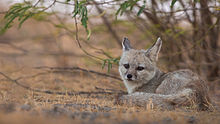Bengal fox
| Bengal fox | |
|---|---|

| |
| Bengal fox in Thar Desert, Rajasthan | |
| Scientific classification | |
| Domain: | Eukaryota |
| Kingdom: | Animalia |
| Phylum: | Chordata |
| Class: | Mammalia |
| Order: | Carnivora |
| Family: | Canidae |
| Genus: | Vulpes |
| Species: | V. bengalensis
|
| Binomial name | |
| Vulpes bengalensis (Shaw, 1800)
| |

| |
| Range map | |
| Synonyms | |
| |
The Bengal fox (Vulpes bengalensis), also known as the Indian fox, is a
Appearance

Vulpes bengalensis is a relatively small fox with an elongated muzzle, long, pointed ears, and a long, bushy tail. The
The Bengal fox is more daintily built than the red fox (V. vulpes), and can readily be recognized by its bushy, black-tipped tail, which is around 50–60% of the length of the head and body.[7]
The backs of the ears are dark brown with a black margin, and white inside. The ears have the same colour as the nape or maybe darker, but not having a dark patch as in V. vulpes. Its rhinarium is naked and the lips are black. The muzzle is pointy, and there may be a dark smudged marking along the upper part of muzzle in front of eyes. Extensive variation in coat colour exists across populations and seasonally within populations, but generally varies from grey to pale brown. The head and body length is 18 in (46 cm), with a 10 in (25 cm) long tail. Typical weight is 5 to 9 pounds (2.3 to 4.1 kg).[3]
The genus Vulpes can be separated from Canis and Cuon in the Indian region by the flat forehead between the postorbital processes and not inflated by air cells. The processes themselves are slightly concave with a raised anterior edge (convexly round in other canids). The canine teeth are longer.[8]
Distribution and habitat

The Bengal Fox is endemic to the
Its range is bounded by the
Behaviour and ecology


Bengal foxes are predominantly
Bengal foxes are not especially suspicious of humans and can be found near human habitation. They are easy to tame.[6]
Diet

Bengal foxes are
Their diet consists mainly of
Communication
Bengal foxes make a wide range of vocalizations. A common vocalization is a "chattering cry" that seems to have a significant role in establishing territoriality and may also be used as a warning call.
Reproduction

Bengal foxes are thought to form long-term monogamous pairs, but this supposition is based on scarce evidence
During the day, they tend to rest under shrubs and bushes, except in summer when they rest in dens. Play between pups is typical during the first 3 months and consists of vertical jumps, back arching, foreleg stabs, submissive displays, and play solicitation; the adult male sometimes plays with the young. In northwestern India, young foxes are scattered during the monsoon season, when the opportunities are plentiful.[3] The pups are fully weaned about 3–4 months after emerging from the den. Pup mortality is high during the first few months.[15]
Threats

While the Bengal fox is common, it usually occurs at low densities across its range, and populations may experience significant fluctuations due to prey abundance and disease (canine distemper virus and rabies,[16] which have been confirmed to cause local population declines in western India). Any human disruptions can be tolerated, but with the increase of human populations and the increased growth of grasslands for agricultural and industrial use, the habitat of the Bengal fox is continually being reduced. The combination of the above causes, combined with disease and/or natural mortality, could potentially cause localized extirpation.[1]
Lack of habitat protection is perhaps the greatest threat to the Bengal fox. For example, in southern India, less than 2% of potential Indian fox habitat is covered under the existing protected area network of the states of
The populations of India are listed in the CITES Appendix III. The Indian Wildlife Conservation Act (1972 as amended to 2005) forbids the hunting of all wildlife and lists the Indian Fox in Schedule II. It does not apply to any particular category in the wildlife protection legislation of Nepal. It is listed as
References
- ^ . Retrieved 20 November 2021.
- ^ Vanak, A.T. (2005). "Distribution and status of the Indian fox Vulpes bengalensis in southern India" (PDF). Canid News. 8 (1).
- ^ doi:10.1644/795.1.
- OCLC 62265494.
- ^ Mivart, St George (1890). "Dogs, jackals, wolves and foxes: A monograph of the Canidae". London: R H Porter: 126–131.
{{cite journal}}: Cite journal requires|journal=(help) - ^ ISBN 0-12-639375-3.
- ISBN 978-93-5009-761-8.
- ^ Pocock RI (1937). "The foxes of British India". J. Bombay Nat. Hist. Soc. 39 (1): 36–57.
- .
- ^ ISBN 978-2-8317-0786-0. Archived from the original(PDF) on 2006-07-08.
- ^ a b c d e f Johnsingh, A.J.T. (1978). "Some aspects of the ecology and behaviour of the Indian fox Vulpes bengalensis Shaw". Journal of the Bombay Natural History Society. 75: 397–405.
- .
- ^ a b c Meadors, Pamela (2007). "Vulpes bengalensis (Bengal fox)". Animal Diversity Web. Retrieved 10 November 2020.
- ^ Manakadan, R. & Rahmani, A. R. (2000). "Population and ecology of the Indian fox Vulpes bengalensis at Rollapadu Wildlife Sanctuary, Andhra Pradesh, India". Journal of the Bombay Natural History Society. 97 (1): 3–14.
- S2CID 85247051.
- PMID 25135467.
- ^ Vanak, A.T.; Irfan-Ullah, M. & Peterson, T. (2008). "Gap analysis of Indian fox conservation using ecological niche modeling". Journal of the Bombay Natural History Society. 105 (1): 49–54.

